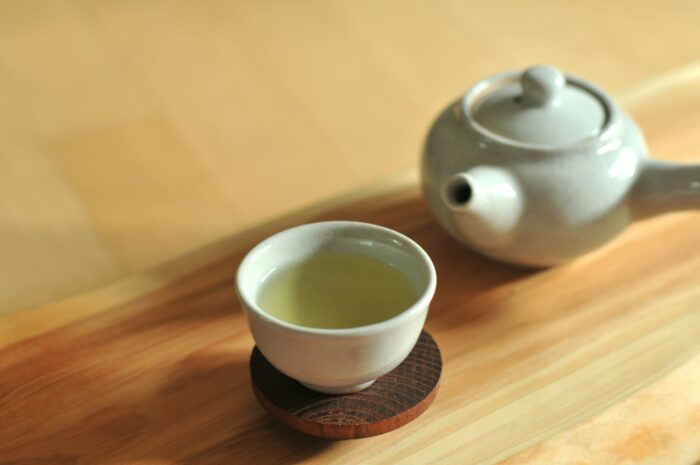Drinking green tea regularly is a healthy habit: this plant stands out among other teas because of its numerous benefits. Beyond its fresh, grassy taste, green loose leaf tea embodies a rich blend of cultures and traditions. Its journey from leaf to cup is a testament to the harmony between nature and human cultivation. From the misty mountains of China to serene Japanese tea gardens, green tea is grown and enjoyed by millions of people every day around the world.

Photo by Na visky
Origins and Cultivation
The story of green tea begins in ancient China, where legend credits Emperor Shen Nong with its discovery over 4,000 years ago. Since then, the cultivation of Camellia sinensis, the plant from which all true teas are derived, has spread across the globe. Today, regions such as Japan, India, and even parts of Africa contribute to the vast tapestry of green tea production. Cultivated with care and attention to detail, green tea plants thrive in diverse climates, from high mountain slopes to coastal plains.
Harvesting and Processing
The journey from leaf to cup is a meticulous process that begins with the tender plucking of young tea leaves. In traditional tea-growing regions, like Kerala or Rwanda, skilled artisans handpick each leaf, ensuring only the finest quality ends up in your teapot. Once harvested, the leaves undergo careful processing to preserve their delicate flavours and beneficial properties. Unlike black tea, which undergoes full oxidation, green tea is minimally processed to maintain its vibrant green hue and fresh taste.

Brewing and Enjoyment
The art of brewing green tea is a ritual steeped in tradition and mindfulness. Whether using a traditional Chinese gaiwan or a sleek Japanese kyusu, the process begins with heating water to the perfect temperature. Too hot, and the delicate flavours of the tea may become bitter; too cool, and the full spectrum of aromas may not fully emerge. With water at the optimal temperature, the tea leaves are gently steeped, releasing their essence into the liquid. As the tea infuses, its health-promoting compounds mingle with the water, creating a beverage that nourishes both body and soul. Whether sipped slowly in quiet contemplation or shared among friends, green tea invites us to embrace the present moment and savor the simple pleasures of life.

Health Benefits and Scientific Insights
While green tea has been cherished for centuries for its refreshing taste, its health benefits have garnered increasing attention in recent years. Packed with antioxidants such as catechins and polyphenols, green tea has been linked to a myriad of health-promoting compounds, including improved heart health, enhanced brain function, and even potential cancer-fighting properties. Studies have also suggested that regular consumption of green tea may aid in weight loss and support a healthy metabolism. With each sip, green tea offers a holistic approach to wellness, nourishing the body and nurturing the mind.
Cultural Significance and Rituals
Beyond its physiological effects, green tea holds deep cultural significance in many societies. In Japan, the tea ceremony, or chanoyu, is a revered tradition that celebrates harmony, respect, and tranquility. Rooted in Zen Buddhism, the tea ceremony elevates the act of tea preparation to an art form, encouraging participants to cultivate mindfulness and appreciation for the present moment. Similarly, in China, the act of serving tea is a gesture of hospitality and friendship, symbolizing the bond between host and guest. Whether enjoyed in a formal setting or as a daily ritual, green tea connects us to centuries of tradition and shared humanity.

Varieties and Flavours
While green tea is often associated with a grassy, vegetal taste, its flavour profile is as diverse as the regions in which it is grown. From the delicate sweetness of Japanese sencha to the boldness of Chinese Longjing, each variety offers a unique sensory experience. Floral notes, nutty undertones, and hints of seaweed are just a few of the flavours that can be found in different types of green tea. Whether you prefer a steamed Japanese green or a pan-fried Chinese green, exploring the vast world of green tea is a journey of discovery and delight.

Sustainability and Ethical Practices
As awareness of environmental and social issues grows, consumers are increasingly concerned about the sustainability and ethical practices of the products they purchase. Fortunately, many green tea producers are committed to sustainable agriculture and fair labor practices. By supporting companies that prioritize environmental stewardship and social responsibility, consumers can ensure that their tea-drinking habits contribute to positive change. From organic farming methods to fair trade certification, there are many ways to support a more sustainable tea industry and promote the well-being of both people and the planet.
From leaf to cup, green tea embodies the essence of wellness and mindfulness. Its journey from ancient China to modern tea houses is a testament to the enduring appeal of this beloved beverage. With its rich cultural heritage and diverse flavors, green tea invites us to slow down, savor the moment, and nourish our bodies and souls. Whether enjoyed alone or shared with loved ones, a cup of green tea is more than just a beverage—it’s a celebration of life’s simple pleasures and a reminder to embrace the beauty of the present moment.










